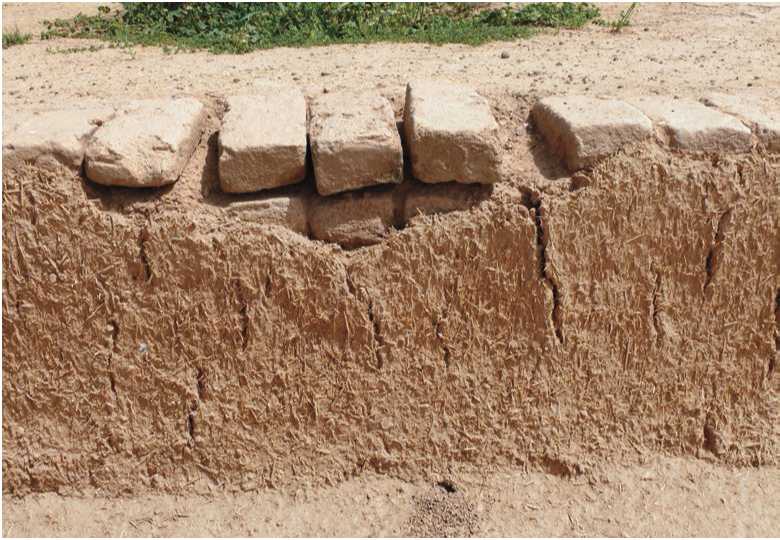In Mesopotamia, river clay provided an excellent substitute for stone, which was in short supply and even for wood, which was a commodity that became rarer as time went on and forests were leveled to increase farmland. The flrst usage was in the ninth millennium bce, when it was fashioned into bricks of various sizes at Nemrik, about 55 kilometers northwest of Mosul in today’s Iraq. By the seventh millennium, mud bricks were common through the region. Some are cigar-shaped and others loaf-shaped. Eventually the advantages of mortar as a bonding agent were discovered, which necessitated rectangular forms. The shared dimension of

Figure 8.24: Reconstruction of mud brick wall, Susa, Iran. Source: Pentocelo, Public Domain
Bricks enabled a skilled bricklayer to produce thousands of identical bricks (Figure 8.24). The preferred brick manufacturing time was between May and June, immediately after the spring rains, when water would be plentiful and the whole summer lay ahead if necessary for drying. Furthermore, chaff and straw was also still available. July to August was therefore the usual time for building when the dryness of the ground facilitated foundation laying. Eventually, in the third millennium, kiln-dried bricks were being made, but because of their high production cost and the need for a lot of timber, these bricks were used mainly for palaces and temples.
At many sites in Mesopotamia, the interior wall surfaces were plastered with gypsum, a feature that was to remain a central element of interior finish. From the extensive outcrops of rock gypsum in northern Iraq and Syria, blocks were cut, stacked, and burnt to form an easily transportable white powder. This building material was not only used locally, but was also exported as a trade commodity. Bitumen was also used, mainly for protection against damp and as a mortar. It was also used medicinally, in rituals. Ancient textual evidence reveals the various forms in which it was available, the details of its transport in skins and pottery. In some places it appears almost as a rock, and in other places it oozes to the surface in hot springs. The ancient sources were primarily in the Kirkuk region on the middle Euphrates, where it was ideal for river distribution. Bitumen was diffcult to produce and acquire and it was used mainly for more prestigious buildings.
Timber was used primarily for roof beams. Astonishingly, it was not widely used for columns until the Achaemenid period, around 400 bce. This meant that rooms were limited in their width to 5 meters and were usually 2 to 4 meters. Roofing material constituted a major expense in a building project since it had to be procured from the remote mountain forests. Places like Jarmo that were close to forests had oak beams for roofs. But as there were fewer and fewer forests over time, timber became rarer and eventually, with the Babylonians, had to be imported all the way from Lebanon.19 It has been argued that the deforestation of the Mesopotamian hillsides led to a rapid desertification by 1000 bce.
Reeds, another common material, grew in abundance along the river banks and in the marshes to the south. Assyrian and Babylonian images give us a clear indication of their use and design. The residents of the sadly depleted Iraqi marshes still today build structures that are clearly similar to these. The reeds were also used for the making of boats. Textual evidence points to the existence of bitumen-covered reed-bundle vessels. The recent recovery of twenty-two bitumen fragments on ocean-going vessels belonging to the Ubaid period at Al-Subiyah (northeast Kuwait) is a significant find as it points to maritime trade as early as the sixth millennium bce.




 World History
World History









